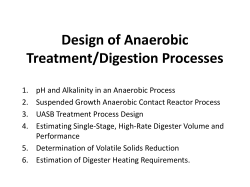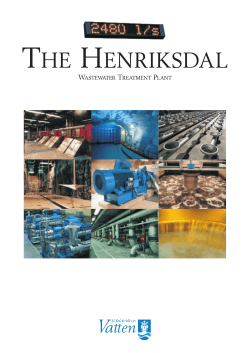
Käppala Association and the Käppala Wastewater Treatment Plant
Käppala Association and the Käppala Wastewater Treatment Plant Connected area, but not member of the Käppala Association KÄPPALA WASTEWATER TREATMENT PLANT Connected area The red line shows the tunnel system for wastewater transport. Sweden Käppala wastewater treatment plant The Käppala wastewater treatment plant is located in the city of Lidingö, just east of Stockholm. Wastewater from over half a million people is treated here. Eleven member municipalities are connected to the plant. The Käppala plant employs a very effective treatment process, and is Sweden’s third-largest wastewater treatment plant. Our goal is clean water in lakes and the archipelago The Käppala Association treats wastewater from over half a million people in eleven municipalities located north and east of Stockholm. Our treatment plant, the Käppala wastewater treatment plant, is Sweden’s third-largest, and employs a very effective treatment process. More than 40 years ago, before the Käppala plant started operating, huge amounts of raw sewage were discharged into local watercourses, lakes and the Stockholm archipelago. This caused problems involving disease transmission and environmental pollution. So in 1957, several municipalities north of Stockholm joined forces and formed the Käppala Association, a local federation, to treat their wastewater. Twelve years later, in 1969, the Käppala wastewater treatment plant in Lidingö was completed – including the 65 km long tunnel system that carries wastewater to the plant from the association’s member municipalities. Following a major rebuilding and extension project, the plant was re-inaugurated in 2000. Nowadays, you can swim and fish in clean water in and around Stockholm, which is unusual compared with many other major European cities. The Käppala Association has been one of the key players behind this positive development. The Käppala plant more than meets the discharge requirements stipulated by the regulatory authority, the County Administrative Board. However, we are not content with that. In accordance with our quality and environmental management system, we strive for continuous improvement and to be able to contribute to a sustainable society. We are keen to test new technologies, partly to make our treatment process even more efficient, partly to increase biogas production, and to be able to produce high-quality sludge. We treat wastewater in the Käppala plant every day of the year, 24 hours a day, and always with a combination of mechanical, biological and chemical treatment. It takes about 1.5 days to treat the waste water before it is returned to nature at a depth of 45 m outside the island of Lidingö. Wastewater treatment in Sweden Approximately 85 percent of Sweden’s population live in areas connected to municipal wastewater treatment facilities. There has been an expansion in municipal sewage treatment since the 1940s. Initially, mechanical treatment was entirely dominant. Biological treatment was introduced on a large scale in the 1960s, and chemical treatment in the 1970s. Today approximately 95 percent of urban wastewater undergoes both biological and chemical treatment. Since the late 1990s, the major treatment plants in the southern part of Sweden have been augmented with a special nitrogen removal step. Source: The Swedish Environmental Protection Agency The wastewater treatment process The treatment process at the Käppala wastewater treatment plant includes five major steps: • • • • • Pre treatment Primary sedimentation Biological treatment Final sedimentation Sand filtration 1. Screens and grit removal Toilet paper and debris are removed from the sewage with rotating step screens. Sand and grit is settled on the bottom of aerated grit chambers. The removed sand and grit is washed, dewatered and then reused. Inlet 11. Fine screens 12. Odour control 13. Grit chamber 14. Primary sedimentation 15. Biological treatment 16. Final sedimentation 17. Sand filter 18. Chemical dosage 19. Digesters 10. Upgrading facility for vehicle fuel 11. Sludge dewatering (Kemicond) 12. Gas boiler 13. Heat pump 2. Odour control The ventilation air from the screens, grit chambers and the primary sedimentation tanks is collected and treated with UV light and activated carbon filters before it is released to a 150 m tall chimney. The treatment effect is more than 95 percent regarding odour units. 3. Primary sedimentation tanks Particulate matter is settled to the bottom of the primary sedimentation tanks. The produced primary sludge is collected with sludge scrapers and thickened before it is pumped to the digesters for production of biogas. 4. Biological treatment Micro-organisms consume the organic material in the water and produce a biological sludge. By controlling the living conditions for the microorganisms nutrients as nitrogen and phosphorus are removed. Nitrogen is transformed to nitrogen gas and is released to the atmosphere. Phosphorus is bound to the biological sludge. 5. Final sedimentation The produced biological sludge is settled to the bottom of the final sedimentation tanks where it is collected with sludge scrapers and pumped back to the biological treatment. A portion of the biological sludge, excess sludge, is pumped to the digesters for production of biogas. 6. Chemical precipitation Some of the phosphorus that is not removed in the biological treatment is precipitated with ferrous iron sulphate. Outflow 7. Sand filters The final treatment step is filtration where particulate matter is removed from the water with sand filters. The treated water is released to the Stockholm archipelago at a depth of 45 m. Kemicond Sludge dewatering Heat pump Sludge silo Digester Nutrients Heat pump Gasometer Gas boiler Upgrading facility District heating for vehicle fuel Biogas Sludge treatment The sludge is pumped into the digesters, where biogas is formed. The biogas is upgraded to vehicle fuel quality, and used as fuel for public transport buses. The digested sludge is treated with chemicals, dewatered, quality checked and then used as an agricultural fertilizer and for production of soil and soil amendment products. We contribute to clean water in our region and recycle nutrients and energy to the community Every year, we treat 50 million cubic metres of wastewater The Käppala plant is an underground facility. Wastewater is treated in large chambers blasted into the rock. Every year, we treat approximately 50 million cubic metres of wastewater. This represents approximately 900,000 bathfuls per day. Treating wastewater is our main task. But we also exploit the nutrients and energy contained in the wastewater, and produce sludge and biogas that are recycled to the community. Our sludge is used as fertilizer by farmers in our region… Our sludge is certified annually in accordance with the Swedish Water & Wastewater Association’s (our industry organisation) certification system REVAQ, and can be used on arable land as an alternative to chemical fertilizers. The sludge is rich in nutrients, among them phosphorus and nitrogen. It undergoes continuous quality control. In recent years, we have been able to improve the quality of the sludge to such an extent that most of the nutrients can now be returned to the ecological cycle and used on arable land in the Stockholm region. The rest is used for production of soil and soil amendment products. ... and we process the biogas into environmentally friendly fuel for public transport buses We produce the biogas in the Käppala plant’s digesters. We upgrade the biogas to vehicle fuel quality in our upgrading facility. The gas is used as an environmentally friendly fuel for public transport buses. In this way, we help reduce the emissions of fossil carbon dioxide in the Stockholm region. Environmentally certified The Käppala Association is environmentally certified in accordance with ISO 14001. Our own laboratory is accredited by SWEDAC in accordance with ISO 17025. Technical data1 Load People equivalents Average flow Maximum flow BOD7 Total nitrogen Total phosphorus 570,000 p e 160,000 m3/d 520,000 m3/d 35 tonnes/d 6 tonnes/d 0.9 tonnes/d BOD7 Total nitrogen Total phosphorus Ammonium Limits 8 mg/L 10 mg/L 0.3 mg/L 3 mg/L (July–October) Treatment results < 3 mg/L 9 mg/L 0.2 mg/L < 1 mg/L Ferrous iron sulphate (18 % Fe) Polymer Sulphuric acid (98%) 2 Hydrogen peroxide (100%) 2 Defoamer2 2,300 tonnes/yr 50 tonnes/yr 2,000 tonnes/yr 200 tonnes/yr 32 m3/yr Electrical consumption Biogas production3 Biogas for vehicle fuel production3 Gas to boilers3 Heat production of boilers3 Heat production for district heating3 31 GWh/yr 6.5 million m3/yr 2 million m3/yr 4.3 million m3/yr 21,100 MWh/yr 14,000 MWh/yr Discharges Chemical consumption Biogas and energy Sludge dewatering TS concentration of dewatered sludge Sludge production 39 % 19,000 tonnes/yr Data from 2010. Used for chemical conditioning in Kemicond. 3 All produced biogas will be upgraded to vehicle fuel quality in the coming years. 1 2 • At the Käppala plant, 99 percent of the organic pollutants and 97 percent of the phosphorus are removed. Nitrogen in the wastewater is reduced by 80 percent. • The Käppala plant’s two digesters produce about 6.5 million cubic metres of biogas each year. The gas is used as vehicle fuel and is sufficient to run about 100 buses. • The Käppala plant started operating in 1969. Between 1994 and 2000, the plant was modernised and a new section was built. Today, the plant has the capacity to treat wastewater from 700,000 people. • The Käppala Association owns and maintains a 65 km long tunnel system with pumping stations that transport wastewater from the member communities’ own sewer systems to the Käppala plant in Lidingö. The Käppala Association is a local federation consisting of eleven munici palities that have joined forces to solve a shared problem: managing and treating the member municipalities’ wastewater. We work in accordance with the cost price principle, on a non-profit basis. The Käppala Association’s board consists of politicians from the member municipalities. We have approximately 40 employees. If you would like to know more about our activities, please visit our website at www.kappala.se. Käppala Association Postal Address Box 3095, SE-181 03 Lidingö Visiting Address Södra Kungsvägen 315, Lidingö Phone +46 8 766 67 00 Fax +46 8 766 67 01 E-mail kappala@kappala.se Website www.kappala.se Photo: Rikkard Häggbom, Johnér Bildbyrå and iStockphoto. Illustrations: Mario Salutskij. Print: Davidsons Tryckeri, september 2011. Eleven municipalities are behind the Käppala Association
© Copyright 2025





















